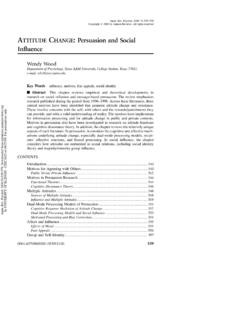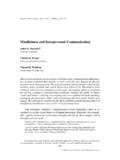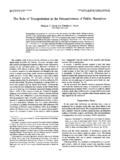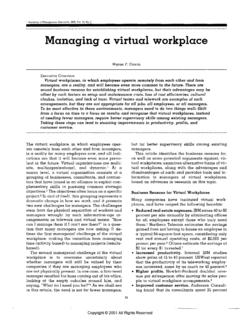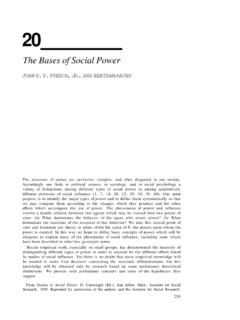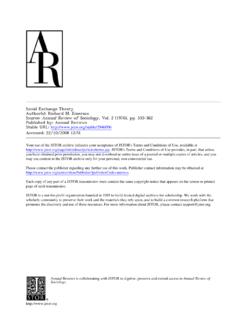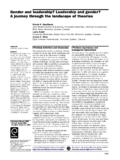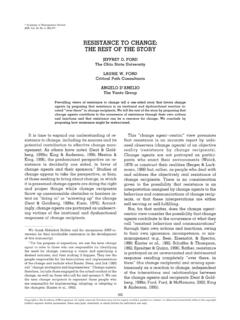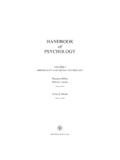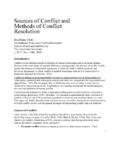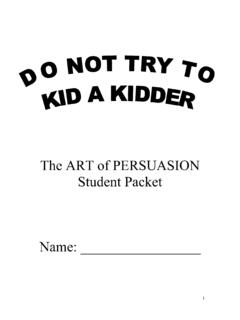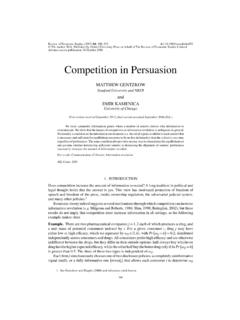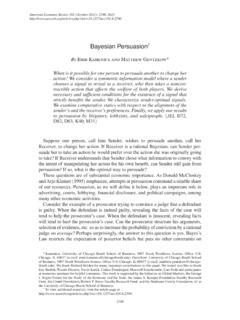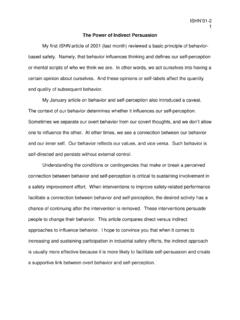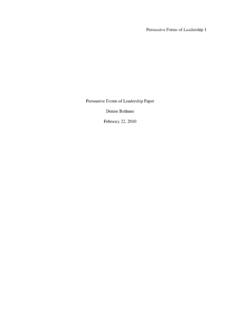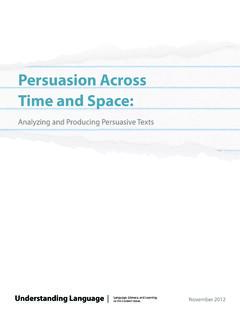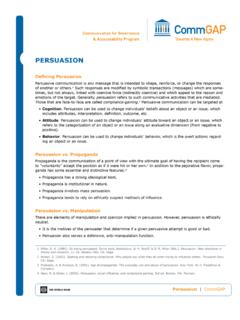Transcription of Persuasion, Frames and Norm Construction
1 persuasion , Frames and NormConstructionRODGER A. PAYNEU niversity of Louisville, USAC onstructivist theorists view norms as shared understandings thatreflect legitimate social purpose . Because the focus is on the ideationalbuilding blocks that undergird a community s shared understandings,rather than material forces, persuasive communication is consideredfundamentally important to norm -building. In practice, this means thatframes are crafted by norm entrepreneurs so as to resonate withaudiences. However, the constructivist empirical literature illustratesthe central importance of material levers in achieving normativechange.
2 Those who promote specific norms also manipulate framesstrategically to achieve their ends and do not necessarily convinceothers to alter their preferences. The global debate over core laborstandards is highlighted to illustrate the various means by which framescan be distorted by communicators acting strategically, perhaps even tosecure their own instrumental interests or to maintain their powerfulstatus. Norms that do not reflect a genuinely voluntary consensus canbe seen as communication constructivist theory Frames (orframing) Habermas international norms persuasionIntroductionSocial constructivists, in stark contrast to the neo-utilitarian scholars whoalmost exclusively highlight the causal force of material interests and power,argue that shared ideas and knowledge are very important building blocksof international reality (Ruggie, 1998: 33).
3 1 Substantial attention, boththeoretical and empirical, has appropriately been focused by constructivistson the development of international norms, structures which by definitionare collective expectations about proper behavior for a given identity European Journal of International RelationsCopyright 2001 SAGE Publications and ECPR, Vol. 7(1): 37 61(1354 0661 [200103] 7:1; 37 61; 016345)(Jepperson et al., 1996: 54). Norms, in other words, constitute a commun-ity s shared understandings and intentions; they are social facts and reflect legitimate social purpose (see Ruggie, 1998).2 Agents, of course, translate ideas into normative structures.
4 Con-structivists are therefore especially interested in how political actors producethe intersubjective understandings that undergird norms (for example, seeRisse et al., 1999; Barnett, 1999). Great attention has been directed atcommunication, especially at persuasive messages, which attempt, bydefinition, to change actor preferences and to challenge current or createnew collective , persuasion is considered the centrallyimportant mechanism for constructing and reconstructing social to Finnemore (1996: 141; Lynch, 1999), normative claimsbecome powerful and prevail by being persuasive.
5 More broadly, persuasionis the process by which agent action becomes social structure, ideas becomenorms, and the subjective becomes the intersubjective (Finnemore andSikkink, 1998: 914; Klotz, 1995: 29 33).Persuasive messages, however, are not transmitted in an ideationalvacuum. All advocates of normative change confront highly contested contexts where their ideas must compete with other norms and perceptionsof interest (Finnemore and Sikkink, 1998: 897). In fact, a very wide varietyand large number of normative claims are advanced in political debatesworldwide. Scholars working in International Relations unfortunately lack agood theory to explain the persuasiveness of any particular normative claimover others (Legro, 1997).
6 As Risse-Kappen (1994: 187) has argued, decision makers are always exposed to several and often contradictory policyconcepts . Yet, research mostly fails to specify the conditions under whichspecific ideas are selected and influence policies while others fall by thewayside . Weber (1997: 240), who is skeptical of the constructivistapproach, challenges it to explain why one set of knowledge claims wins and why others are left behind .Framing and norm ResonanceA good deal of recent scholarship now addresses this concern. Con-structivists commonly explain persuasion by pointing to the substantivecontent, or intrinsic characteristic, of particular ideas or claims.
7 New ideasare said to resonate because of some ideational affinity to other alreadyaccepted normative frameworks (Keck and Sikkink, 1998a: 204). Forexample, the resonance of shared ethical traditions (Lumsdaine, 1993) andwidely accepted democratic processes (Payne, forthcoming) has beenempirically demonstrated in studies of foreign aid and development their impressive overview of the constructivist literature on norm -European Journal of International Relations 7(1)38building, Finnemore and Sikkink (1998: 906 7) make it clear that agentsintentionally try to connect new normative ideas to established ideaswhen they construct persuasive messages.
8 Successful norm entrepreneurs (Nadelmann, 1990: 482) are therefore those able to frame normative ideasin such a way that they resonate with relevant audiences. Framing, in fact, isviewed as a central element of successful frame is a persuasive device used to fix meanings, organize experience,alert others that their interests and possibly their identities are at stake, andpropose solutions to ongoing problems (Barnett, 1999: 25, 1998). For thepurpose of norm -building, Frames provide a singular interpretation of aparticular situation and then indicate appropriate behavior for that carefully crafted interpretive frame therefore constitutes a social powerresource with relative autonomy from material power resources (Lynch,1999: 265).
9 Frames are basic building blocks for the Construction of broadlyresonant norms and they thereby serve to legitimate normative orders. Theempirical literature provides numerous examples of Frames being meticu-lously fashioned by norm advocates so as to appeal to particular targetcommunities and to mobilize triumphant international change (1998: 628), for example, emphasizes that the successful proponentsof a landmine ban framed that issue in terms of the indiscriminate nature oftheir effects , thereby grafting on to the debate a resonant idea fromvarious campaigns against weapons of mass destruction.
10 Keck and Sikkink(1998a, 1998b) likewise document effective employment of Frames relatedto the prevention of bodily harm in their thoughtful study of human rightsand other QuestionsThis article analyzes persuasion in norm -building and criticizes the standardconstructivist account. Legitimate, authoritative norms reflect genuinelyshared understandings. persuasion should accordingly be evaluated as asocial process, though too much of the constructivist literature, oddlyenough, is insufficiently attentive to social concerns. My overarching thesis,informed by Habermasian critical theory, is that the constructivist explana-tion of norm -building, currently centered upon persuasive Frames and theresonance of particular claims, is ultimately limited and flawed.
